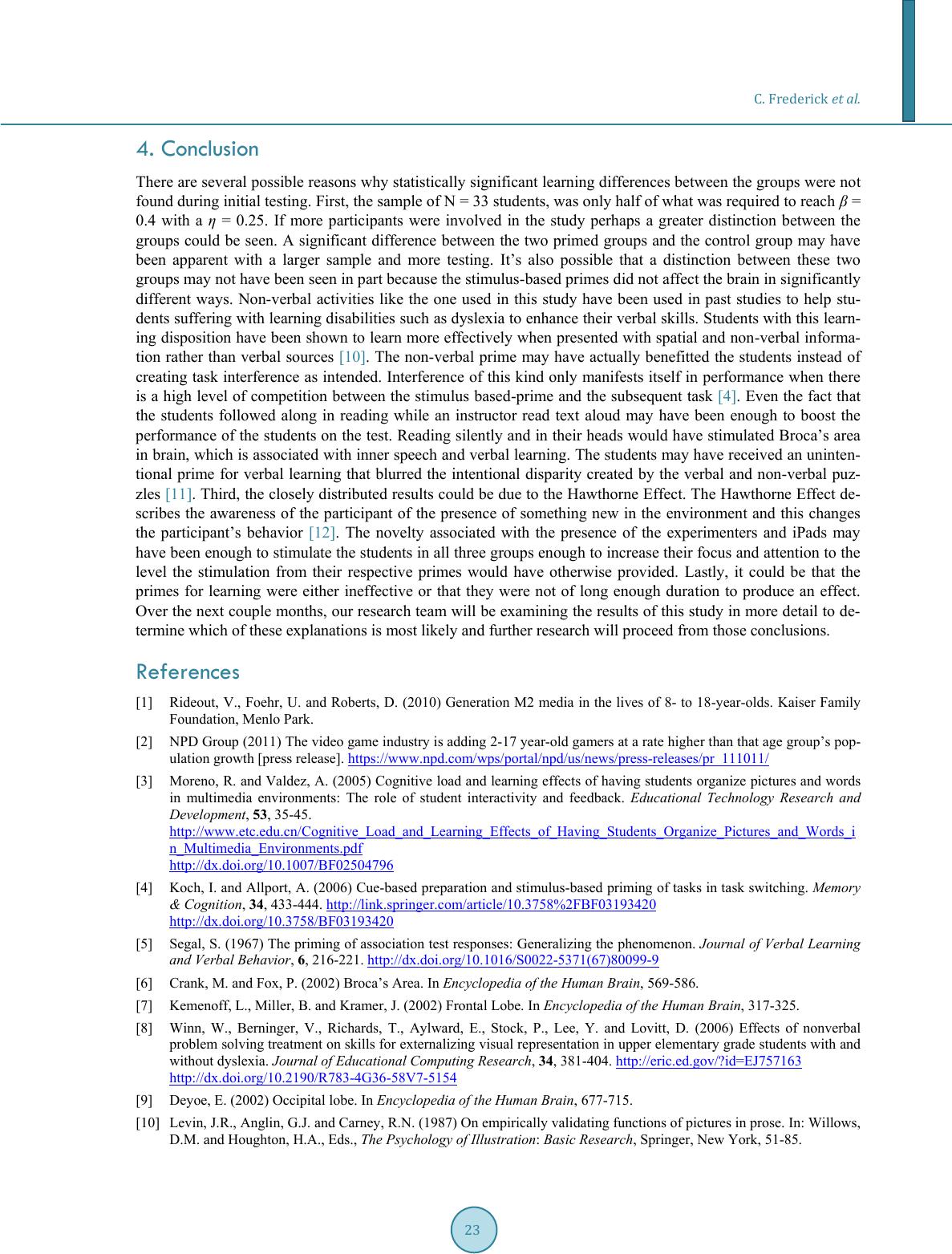
C. Frederick et al.
4. Conclusion
There are several possible reasons why statistically significant learning differences between the groups were not
found during initial testing. First, the sample of N = 33 students, was only half of what was required to reach β =
0.4 with a ƞ = 0.25. If more participants were involved in the study perhaps a greater distinction between the
groups could be seen. A significant difference between the two primed groups and the control group may have
been apparent with a larger sample and more testing. It’s also possible that a distinction between these two
groups may not have been seen in part because the stimulus-based primes did not affect the brain in significantly
different ways. Non-verbal activities like the one used in this study have been used in past studies to help stu-
dents suffering with learning disabilities such as dyslex ia to enhance their verbal skills. Students with this learn-
ing disposition have been shown to learn more effectively when presented with spatial and non -verbal informa-
tion rather than verbal sources [10]. The non-verbal prime may have actually benefitted the students instead of
creating task interference as intended. Interference of this kind only manifests itself in performance when there
is a high level of competition between the stimulus based-prime and the subsequent task [4]. Even the fact that
the students followed along in reading while an instructor read text aloud may have been enough to boost the
performance of the students on the test. Reading silently and in their heads would have stimulated Broca’s area
in brain, which is associated with inner speech and verbal learning. The students may have received an uninten-
tional prime for verbal learning that blurred the intentional disparity created by the verbal and non-verbal puz-
zles [11]. Third, the closely distributed results could be due to the Hawthorne Effect. The Hawthorne Effect de-
scribes the awareness of the participant of the presence of something new in the environment and this changes
the participant’s behavior [12]. The novelty associated with the presence of the experimenters and iPads may
have been enough to stimulate the students in all three groups enough to increase their focus and attention to the
level the stimulation from their respective primes would have otherwise provided. Lastly, it could be that the
primes for learning were either ineffective or that they were not of long enough duration to produce an effect.
Over the next couple months, our research team will be examining the results of this study in more detail to de-
termine which of these explanations is most likely and further research will proceed from those conclusions.
References
[1] Rideout, V., Foehr, U. and Roberts, D. (2010) Generation M2 media in the lives of 8- to 18-y ear-olds. Kaiser Family
Foundation, Menlo Park.
[2] NPD Group (2011) The video game industry is adding 2-17 year-old gamers at a rate higher than that age group’s pop-
ulation growth [press release]. https://www.npd.com/wps/portal/npd/us/news/press-releases/pr_111011/
[3] Moreno, R. and Valdez, A. (2005) Cognitive load and learning effects of having students organize pictures and words
in multimedia environments: The role of student interactivity and feedback. Educational Technology Research and
Development, 53, 35-45.
http://www.etc.edu.cn/Cognitive_Load_and_Learning_Effects_of_Having_Students_Organize_Pictures_and_Words_i
n_Multimedia_Environments.pdf
http://dx.doi.org/10.1007/BF02504796
[4] Koch, I. and Allport, A. (2006) Cue-based preparation and stimulus-based priming of tasks in task switching. Memory
& Cognition, 34, 433-444. http://link.springer.com/article/10.3758%2FBF03193420
http://dx.doi.org/10.3758/BF03193420
[5] Segal, S. (1967) The priming of association test responses: Generalizing the phenomenon. Journal of Verbal Learning
and Verbal Behavior, 6, 216-221. http://dx.doi.org/10.1016/S0022-5371(67)80099-9
[6] Crank, M. and Fox, P. (2002) Broca’s Area. In Encyclopedia of the Human Brain, 569-586.
[7] Kemenoff, L., Miller, B. and Kramer, J. (2002) Frontal Lobe. In Encyclopedia of the Human Brain, 317-325.
[8] Winn, W., Berninger, V., Richards, T., Aylward, E., Stock, P., Lee, Y. and Lovitt, D. (2006) Effects of nonverbal
problem solving treatment on skills for externalizing visual representation in upper elementary grade students with and
without dyslexia. Journal of Educational Computing Research, 34, 381-404. http://eric.ed.gov/?id=EJ757163
http://dx.doi.org/10.2190/R783-4G36-58V7-5154
[9] Dey oe, E. (2002) Occipital lobe. In Encyclopedia of the Human Brain, 677-715.
[10] Levin, J.R., Anglin, G.J. and Carney, R.N. (1987) On empirically validating functions of pictures in prose. In: Willows,
D.M. and Houghton, H.A., Eds., The Psychology of Illustration: Basic Research, Springer, New York, 51-85.